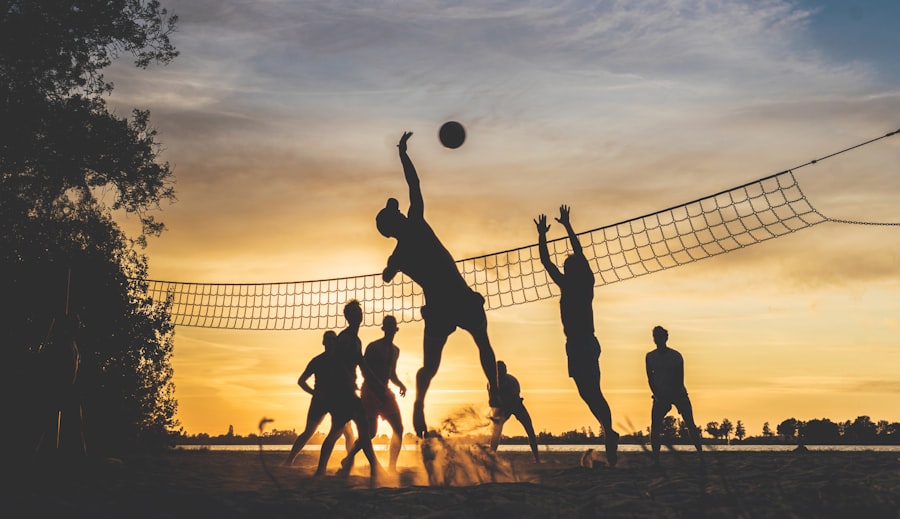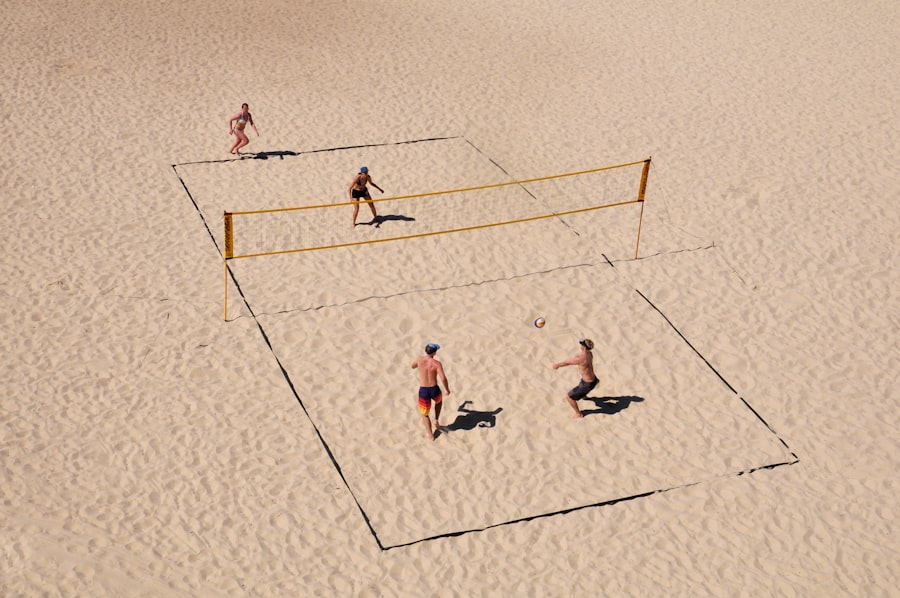Download links
How to install Mastering the Art of Volleyball: Tips for Success APK?
1. Tap the downloaded Mastering the Art of Volleyball: Tips for Success APK file.
2. Touch install.
3. Follow the steps on the screen.
Description
Volleyball is a dynamic sport that combines elements of strategy, athleticism, and teamwork. At its core, the game is played between two teams, each aiming to score points by sending a ball over a net and landing it within the opponent’s court. The fundamental rules are straightforward: a team can touch the ball a maximum of three times before it must cross the net, and players cannot hit the ball twice in succession.
Understanding these basic rules is essential for any player or coach, as they form the foundation upon which more complex strategies and techniques are built. The court itself is a rectangular area measuring 18 meters long and 9 meters wide, divided by a net that stands at a height of 2.43 meters for men and 2.24 meters for women.
Each team consists of six players who occupy specific positions on the court: three front-row players and three back-row players. The front-row players are primarily responsible for attacking and blocking, while the back-row players focus on defense and serve reception. Familiarity with these positions and their roles is crucial for effective gameplay.
Players must also understand rotation rules, which dictate how teams shift positions after winning a serve from the opposing team. This knowledge not only enhances individual performance but also fosters better coordination among teammates.
Key Takeaways
- Volleyball requires understanding of fundamental rules and strategies
- Proper technique for serving, passing, and hitting is essential for success
- Communication and teamwork are crucial for effective play on the court
- Mastering defensive skills such as blocking and digging is important for a well-rounded game
- Physical fitness and conditioning are key for peak performance in volleyball
- Mental preparation and focus are necessary for success in volleyball
Developing Proper Technique for Serving, Passing, and Hitting
Mastering the fundamental skills of serving, passing, and hitting is vital for any volleyball player aspiring to excel in the sport. Serving is often the first opportunity a player has to impact the game, making it essential to develop a reliable and effective serve. There are various types of serves, including the underhand serve, overhand serve, and jump serve.
The overhand serve is particularly powerful when executed correctly, as it allows for greater speed and spin on the ball. To achieve this, players must focus on their toss, hand positioning, and follow-through. A consistent toss sets up the serve, while proper hand positioning ensures that the ball is struck cleanly.
Passing, or reception, is another critical skill that requires precision and technique. The primary objective of passing is to accurately direct the ball to the setter, who orchestrates the team’s offensive plays. Players should practice the forearm pass (or bump) and overhead pass (or set) to develop versatility in their passing abilities.
The forearm pass involves using the forearms to create a platform for receiving low balls, while the overhead pass requires players to use their fingers to guide higher balls with finesse. Both techniques demand proper footwork, body positioning, and timing to ensure successful execution. Hitting is perhaps one of the most exhilarating aspects of volleyball, as it involves attacking the ball with power and precision.
A successful hit requires a combination of approach timing, arm swing mechanics, and body positioning. Players must learn to time their jump effectively to meet the ball at its highest point while maintaining balance and control. The arm swing should be fluid and explosive, generating maximum force upon contact with the ball.
Additionally, understanding different hitting techniques—such as line shots, cross-court hits, and tips—enables players to keep defenders guessing and create scoring opportunities.
Improving Communication and Teamwork on the Court

Effective communication is paramount in volleyball, where split-second decisions can determine the outcome of a play. Players must develop a common language that facilitates quick exchanges of information during matches. This includes calling for the ball, signaling plays, and providing feedback to teammates. Simple phrases like “mine” or “got it” can help prevent collisions and ensure that players are aware of each other’s intentions. Moreover, non-verbal communication through eye contact and body language can enhance understanding among teammates during high-pressure situations. Teamwork extends beyond verbal communication; it encompasses trust and synergy among players. A cohesive team operates like a well-oiled machine, where each member understands their role and responsibilities within the system.
Regular practice sessions focused on drills that promote teamwork—such as cooperative passing exercises or scrimmages—can help build this rapport. Additionally, team-building activities off the court can strengthen relationships among players, fostering an environment where individuals feel comfortable supporting one another during matches.
Mastering Defensive Skills, including Blocking and Digging
| Player | Blocking Average | Digging Average |
|---|---|---|
| Player 1 | 0.8 | 2.5 |
| Player 2 | 1.2 | 3.0 |
| Player 3 | 0.9 | 2.8 |
Defensive skills are crucial in volleyball as they can significantly influence a team’s ability to thwart opponents’ attacks. Blocking is one of the primary defensive techniques used to prevent an opposing player from successfully hitting the ball over the net. A well-timed block requires anticipation of the hitter’s approach and an understanding of their tendencies.
Players must position themselves correctly at the net, using their arms to create a barrier while jumping at the right moment to maximize their reach. Effective blocking not only stops attacks but can also redirect the ball back into play or set up counter-attacks. Digging is another essential defensive skill that involves receiving hard-driven attacks from opponents.
A successful dig requires quick reflexes and proper body positioning to absorb the impact of the ball while maintaining control. Players should practice various digging techniques, such as using their forearms or hands to receive different types of hits. Additionally, developing a keen sense of court awareness allows defenders to anticipate where attacks are likely to land, enabling them to position themselves effectively for successful digs.
Enhancing Physical Fitness and Conditioning for Volleyball
Physical fitness plays a pivotal role in a volleyball player’s performance on the court. The sport demands a unique combination of strength, agility, endurance, and flexibility. To enhance overall fitness levels, players should engage in a well-rounded conditioning program that includes cardiovascular exercises, strength training, and flexibility routines.
Cardiovascular fitness is essential for maintaining energy levels throughout matches; activities such as running or cycling can improve stamina. Strength training should focus on developing core muscles, leg power, and upper body strength—key components for jumping ability and powerful hitting. Exercises like squats, lunges, and plyometric drills can enhance explosive power necessary for effective jumping and quick lateral movements on the court.
Flexibility training through stretching or yoga can improve range of motion and reduce injury risk by promoting muscle elasticity. In addition to general fitness routines, volleyball-specific drills can further enhance physical conditioning. These may include agility ladder drills for foot speed or resistance training with bands to simulate game-like movements.
Incorporating these specialized exercises into regular training regimens helps players develop sport-specific skills while improving overall athleticism.
Mental Preparation and Focus for Success in Volleyball

Mental preparation is often overlooked in sports training but is crucial for achieving success in volleyball. The ability to maintain focus during high-pressure situations can significantly impact performance levels. Players should develop mental strategies that help them stay composed under stress—this may include visualization techniques where athletes imagine themselves executing successful plays or positive affirmations that reinforce confidence.
Additionally, mindfulness practices can enhance concentration during matches by teaching players how to remain present in the moment rather than dwelling on past mistakes or worrying about future outcomes. Techniques such as deep breathing exercises can help calm nerves before critical serves or spikes, allowing players to approach each play with clarity and purpose. Building resilience is another vital aspect of mental preparation in volleyball.
Athletes must learn to cope with setbacks—whether it’s losing a point or facing a tough opponent—by developing a growth mindset that views challenges as opportunities for improvement rather than insurmountable obstacles. This mental fortitude not only enhances individual performance but also contributes positively to team dynamics by fostering an environment where players support one another through adversity. In conclusion, volleyball is a multifaceted sport that requires a blend of technical skills, physical fitness, teamwork, and mental resilience.
By understanding its fundamentals and honing essential skills such as serving, passing, hitting, blocking, digging, communication, and conditioning, players can elevate their game significantly. Moreover, mental preparation plays an equally important role in achieving success on the court by fostering focus and resilience in challenging situations. Through dedicated practice and commitment to improvement in all these areas, athletes can unlock their full potential in volleyball.
If you’re a fan of volleyball, you may also be interested in reading about the World Soccer Champs Premium APK. This article discusses a popular soccer game that allows players to experience the excitement of being a soccer champion. Check it out here for more information on this thrilling sports game.
FAQs
What is volleyball?
Volleyball is a team sport in which two teams of six players are separated by a net. The objective is to score points by grounding the ball on the opposing team’s court.
What are the basic rules of volleyball?
The basic rules of volleyball include serving the ball over the net, rallying to keep the ball in play, and trying to score points by grounding the ball on the opposing team’s court. Each team is allowed three touches to return the ball.
What are the different types of volleyball games?
There are several variations of volleyball, including indoor volleyball, beach volleyball, and sitting volleyball. Each variation has its own set of rules and playing environment.
What equipment is needed to play volleyball?
The main equipment needed to play volleyball includes a volleyball, a net, and appropriate footwear. Players may also wear knee pads and other protective gear.
What are the health benefits of playing volleyball?
Playing volleyball can improve cardiovascular health, enhance muscle strength and coordination, and promote teamwork and communication skills. It is also a great way to stay active and socialize.
What are the key skills needed to excel in volleyball?
Key skills for volleyball include serving, passing, setting, attacking, blocking, and digging. Players also need good communication, teamwork, and strategic thinking.





